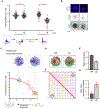3D genomics across the tree of life reveals condensin II as a determinant of architecture type
- PMID: 34045355
- PMCID: PMC8172041
- DOI: 10.1126/science.abe2218
3D genomics across the tree of life reveals condensin II as a determinant of architecture type
Abstract
We investigated genome folding across the eukaryotic tree of life. We find two types of three-dimensional (3D) genome architectures at the chromosome scale. Each type appears and disappears repeatedly during eukaryotic evolution. The type of genome architecture that an organism exhibits correlates with the absence of condensin II subunits. Moreover, condensin II depletion converts the architecture of the human genome to a state resembling that seen in organisms such as fungi or mosquitoes. In this state, centromeres cluster together at nucleoli, and heterochromatin domains merge. We propose a physical model in which lengthwise compaction of chromosomes by condensin II during mitosis determines chromosome-scale genome architecture, with effects that are retained during the subsequent interphase. This mechanism likely has been conserved since the last common ancestor of all eukaryotes.
Copyright © 2021 The Authors, some rights reserved; exclusive licensee American Association for the Advancement of Science. No claim to original U.S. Government Works.
Conflict of interest statement
Competing interests
All authors declare that they have no competing interests.
Figures




Similar articles
-
Condensin I associates with structural and gene regulatory regions in vertebrate chromosomes.Nat Commun. 2013;4:2537. doi: 10.1038/ncomms3537. Nat Commun. 2013. PMID: 24088984 Free PMC article.
-
Compacting DNA during the interphase: condensin maintains rDNA integrity.Cell Cycle. 2007 Sep 15;6(18):2213-8. doi: 10.4161/cc.6.18.4733. Epub 2007 Jul 11. Cell Cycle. 2007. PMID: 17671437 Review.
-
Condensin-mediated remodeling of the mitotic chromatin landscape in fission yeast.Nat Genet. 2017 Oct;49(10):1553-1557. doi: 10.1038/ng.3938. Epub 2017 Aug 21. Nat Genet. 2017. PMID: 28825727 Free PMC article.
-
Condensin II promotes the formation of chromosome territories by inducing axial compaction of polyploid interphase chromosomes.PLoS Genet. 2012;8(8):e1002873. doi: 10.1371/journal.pgen.1002873. Epub 2012 Aug 30. PLoS Genet. 2012. PMID: 22956908 Free PMC article.
-
The loading of condensin in the context of chromatin.Curr Genet. 2017 Aug;63(4):577-589. doi: 10.1007/s00294-016-0669-0. Epub 2016 Dec 1. Curr Genet. 2017. PMID: 27909798 Review.
Cited by
-
A comparative analysis of planarian genomes reveals regulatory conservation in the face of rapid structural divergence.Nat Commun. 2024 Sep 19;15(1):8215. doi: 10.1038/s41467-024-52380-9. Nat Commun. 2024. PMID: 39294119 Free PMC article.
-
CWL-Based Analysis Pipeline for Hi-C Data: From FASTQ Files to Matrices.Methods Mol Biol. 2025;2856:79-117. doi: 10.1007/978-1-0716-4136-1_6. Methods Mol Biol. 2025. PMID: 39283448
-
A Constitutive Heterochromatic Region Shapes Genome Organization and Impacts Gene Expression in Neurospora crassa.bioRxiv [Preprint]. 2024 Oct 14:2024.06.07.597955. doi: 10.1101/2024.06.07.597955. bioRxiv. 2024. PMID: 39229016 Free PMC article. Preprint.
-
Orientation-independent-DIC imaging reveals that a transient rise in depletion attraction contributes to mitotic chromosome condensation.Proc Natl Acad Sci U S A. 2024 Sep 3;121(36):e2403153121. doi: 10.1073/pnas.2403153121. Epub 2024 Aug 27. Proc Natl Acad Sci U S A. 2024. PMID: 39190347 Free PMC article.
-
Single-nucleosome imaging unveils that condensins and nucleosome-nucleosome interactions differentially constrain chromatin to organize mitotic chromosomes.Nat Commun. 2024 Aug 21;15(1):7152. doi: 10.1038/s41467-024-51454-y. Nat Commun. 2024. PMID: 39169041 Free PMC article.
References
-
- Rabl C, Morphol. Jahrb 10, 214–330 (1885).
-
- Hirano T, Cell. 164, 847–857 (2016). - PubMed
Publication types
MeSH terms
Substances
Grants and funding
LinkOut - more resources
Full Text Sources
Other Literature Sources
Molecular Biology Databases

